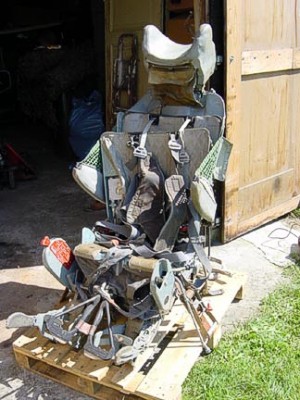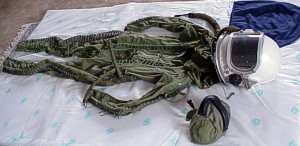|
Following
article appeared for the first time in Air Forces Monthly march
2000. It has been altered for use on this website and published
with kind permission of Key Publishing Ltd.

Record
Breaking
Now a senior test pilot for the Sokol Aircraft building plant,
Alexander Konovalov wrote history in august 1981. Not known to
the Western World until 1999, he is the only* pilot who survived
an ejection at Mach 2.6 at an altitude of 59,055 feet.
*after the article was
published in march 2000, a story surfaced about an SR-71 crew
surviving an ejection at an higher altitude and greater speed.
This has not been confirmed by official sources.
Routine Flight
At the time, Alexander Konovalov was a new graduate of the
Russian Test Pilot School. After having served as a pilot in the
Soviet Airforce, he started flying for GAZ 21 (State Aircraft
Plant 21) at Gorki. These days GAZ 21 has been renamed Sokol and
Gorki is known as Nizhny Novgorod. Starting out as any other day
at the Sormovo airfield for Alexander, he was to conduct an
engine-related air test of a MiG-25R Foxbat-B reconnaissance
fighter. The air test involved an acceleration check from Mach
2.4 to Mach 2.7 at more then 59,000 feet. The Foxbat was going
to make his second flight after a major overhaul.
After completing his pre-flight checks he lined up on the long
runway of Sormovo. As he selected afterburner the big and heavy
jet started his way to the end of the runway. After a normal
take-off and climb-out, Konovalov rehearsed the test program in
his mind and settled down for another routine flight into the
exclusive world of Mach 2.5+. Having reached his briefed
altitude of 18.000 m he established his speed at Mach 2.4 before
commencing the tasked acceleration run up to Mach 2.7. While
accelerating he reached an altitude of 18.600 m when he suddenly
heard a thud from the left side of his Foxbat. At the same time
a red warning light flashed.
Ejection
The sudden port engine failure caused the aircraft to tumble
uncontrollably through the skies.
Konovalov was forced against the right side of the cockpit and
his vision was reduced to a gray blur. He was not able to gain
control of the aircraft and he realized he only had milliseconds
to abandon it. Due to the giant forces on the airframe, the
Foxbat started to break up. Konovalov struggled against the
g-force and managed to squeeze and pull one of the actuating
handles of his KM-1M ejection seat. Blasted out of the
pressurised cockpit into the near vacuum of the upper
stratosphere, making him the first pilot in history to survive
an ejection at well over twice the speed of sound. The entire
sequence of events did not take more than three seconds from
explosion to ejection.

The
KM-1M ejection seat was only shortly before Konovalov’s escape
cleared for speeds greater than Mach 1.8. The two red handles
between the legs of the pilot can be pulled together or
individually to initiate the ejection sequence. The pilots legs
are pulled towards the seat and arm protectors come down both
sides. Further protection comes from the two-stage seat firing
mechanism. This limits the short duration g-force on ejection to
no more than 20G acting from head to the bas of the spine. The
seat however, is not equipped with a frontal deflector plate, as
seen on the later Zvezda K-36, and gives no protection to the
enormous windblast.
Another factor contributing to his survival in the extreme
conditions was his KKO-5 (Komplekt kislorodnovo Oborudovaniya 5)
assembly. This oxygen equipment assembly consist of a Gsh-6 (Germoshlem
6) pressure helmet and a VKK-6 (Vysotno-Kopensiruyushchi Kosyum)
partial pressure suit with special gloves and boots.

The
tubes and pipe-work of the VKK suit are designed to squeeze the
body and limbs to give counter pressure. The tubular exo-skeleton
and internal bladders of the VKK-6 pressure suit inflated
instantaneously with nitrogen as soon as the canopy is blown off
in the initial ejection sequence. Without protection of his suit
and pressure helmet, Konovalovs lungs filled with air at cockpit
pressure, would have expanded three or four times their original
volume. (Boyle’s law: at constant temperature, the volume of a
gas is inversely proportional to its pressure)
This would have been fatal within seconds and the ejection
altitude was also very close to the so-called Armstrongs Line.
The blood of an unprotected human would boil at body
temperature.

The
visor on the GSh-6 is electrically heated to keep it from
fogging. It snaps down tightly onto a gasket surrounding the
faceplate opening. The locking neck-ring with rubber gasket (two
variants - one, a latex very light rubber, and the second, a
much more rigid gray rubber for higher altitude flights) is an
integral part of the GSh-6 as it marries up with the altitude
compensation suit to provide the complete pressure package. The
helmet does not have integrated communications, but it does have
a T-shaped trench on the inside that marries up with the cloth
insert helmet. This helmet has a leather encased foam
"T" that fits into the grooves on the inside of the
helmet shell. This cloth helmet has the integrated
communications package - two headphones and a boom microphone on
the right side. The headphones are covered with soft lambskin
Free Fall
After ejection, the seat is retarded by the primary drogue chute
to a speed permitting the deployment of the secondary chute. The
latter process is designed to occur after 1.5 seconds and caters
for ejections up to the original permitted maximum speed of
1,200 kph. It is likely that the secondary drogue chute operated
faultlessly and remained intact on deployment. Konovalov faced a
free-fall descent of around 15,000 m before the pre-set seat
separation and main parachute deployment would occur. The
free-fall lasted some three minutes.
At the designated height the barometric seat separation
mechanism operated without a hitch. As the seat fell away, the
parachute canopy cracke open and he was finally able to unlock
the visor of his Gsh-6. After landing in a ploughed field, he
stood up after a few seconds and bowed over to his parachute and
said :”Thank you”.
Test pilot career
Within a month after his extraordinary experience, Konovalov was
back in the cockpit and resumed his career as a test pilot.
Working at Nizhny Novgorod and in countries as diverse as
Vietnam and Syria to perform post-delivery tests.
Thanks to Major
Graig Martelle for the VKK-6 and Gsh-6 pictures and some
additional info. |